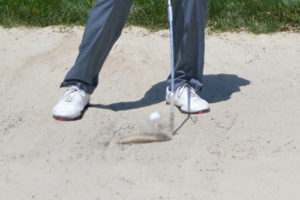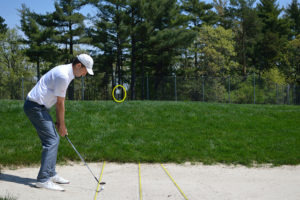If you’ve ever watched golf on television, I can almost guarantee you’ve heard one of golf broadcasting’s favorite phrases, “He was sure lucky to have found the greenside bunker!” But wait, I thought bunkers were supposed to be a penalty? I’m sure many of you have wondered how the Tour players can make it look so easy when most amateurs are happy just to get the ball on the green from the bunker. So why are bunkers so daunting to many recreational golfers?
 I’m here to tell you, “It’s MY FAULT!” Well, maybe not me personally, but golf instruction as a whole has not done a great job in simplifying the process of extricating yourself from a greenside bunker. Most compulsive weekend warriors have a plethora of exotic tips from their favorite golf publication lying deep in their subconscious. I know because they come to me for lessons and have told me all of them. When I have a student explain to me how they believe they are supposed to play this shot, I usually hear a lengthy diatribe involving opening stances, not aiming at the target, opening the clubface, cutting across the ball and which grain of sand needs to be struck in order to survive this melee. So let’s throw all those tips laying in the recesses of your mind away and start from scratch. I will show you how to make bunker play easy!
I’m here to tell you, “It’s MY FAULT!” Well, maybe not me personally, but golf instruction as a whole has not done a great job in simplifying the process of extricating yourself from a greenside bunker. Most compulsive weekend warriors have a plethora of exotic tips from their favorite golf publication lying deep in their subconscious. I know because they come to me for lessons and have told me all of them. When I have a student explain to me how they believe they are supposed to play this shot, I usually hear a lengthy diatribe involving opening stances, not aiming at the target, opening the clubface, cutting across the ball and which grain of sand needs to be struck in order to survive this melee. So let’s throw all those tips laying in the recesses of your mind away and start from scratch. I will show you how to make bunker play easy!
All you have to do to get the ball onto the green from a greenside bunker consistently is to make a big enough swing to splash the sand sitting directly beneath your ball on the green. Seriously, it’s that easy. Here are five simple steps to make sure you are successful.
1. Hit the sand every time
 It’s virtually impossible to hit your ball over the green if you take sand during your swing. If you commit to taking sand, you will eliminate any concern of going over the green.
It’s virtually impossible to hit your ball over the green if you take sand during your swing. If you commit to taking sand, you will eliminate any concern of going over the green.
Quick Tip: In playing any shot off the ground you are already taking some turf, so taking sand shouldn’t be that hard. Digging into the sand and widening your stance a few inches outside your shoulders will make taking sand unconscious and inevitable.
2. Take a big enough swing to get the ball out
 Now that you’ve resigned yourself to using the sand to your advantage, you won’t have to shrink your backswing to the length of a 5 foot putt in the off-chance you catch all ball and send your playing partners diving for cover. A simple recommendation is to take at least a half backswing and make a full finish. Specifically, your arm closest to the target should be parallel to the ground, and the club should hinge enough to create an “L” shape in your backswing. In your follow through, your chest should be rotated enough to face your target.
Now that you’ve resigned yourself to using the sand to your advantage, you won’t have to shrink your backswing to the length of a 5 foot putt in the off-chance you catch all ball and send your playing partners diving for cover. A simple recommendation is to take at least a half backswing and make a full finish. Specifically, your arm closest to the target should be parallel to the ground, and the club should hinge enough to create an “L” shape in your backswing. In your follow through, your chest should be rotated enough to face your target.
Quick Tip: I rarely teach greenside bunker play until my student is consistent with a 20-50 yard pitch shot. A pitch shot technique and bunker technique are very similar, or in some cases, exactly the same. Talk to your GolfTEC Coach about working on other short game techniques before you put all your efforts into mastering sand play.
3. Take the right amount of sand
 Depending on the type of sand, digging about an inch deep, give or take, is the right amount for most bunker shots. You don’t need my help to decipher how much sand works for you on your home course. How steep your club comes into the sand has a lot to do with this. If you’re a player who rarely digs too deep, play with the clubface square at address, so the leading edge of the club helps you dig out more sand. If you are a player who digs trenches, take your grip with the clubface already turned open. The open clubface will allow the bottom of the club and the “bounce” of the wedge to hit the sand first creating more glide through the sand versus digging at it.
Depending on the type of sand, digging about an inch deep, give or take, is the right amount for most bunker shots. You don’t need my help to decipher how much sand works for you on your home course. How steep your club comes into the sand has a lot to do with this. If you’re a player who rarely digs too deep, play with the clubface square at address, so the leading edge of the club helps you dig out more sand. If you are a player who digs trenches, take your grip with the clubface already turned open. The open clubface will allow the bottom of the club and the “bounce” of the wedge to hit the sand first creating more glide through the sand versus digging at it.
Quick Tip: Don’t ever try to alter how much sand you take if you reliably take the correct amount. The correct amount should propel a shot with a sand wedge or 56 degree lofted club somewhere between the front to the middle of the green. If you want to get a ball to trundle further to the back of the green, play a gap wedge or pitching wedge.
4. Play the ball where your splash is
 This step could be the most important aspect of playing a quality bunker shot. It’s also very inconsistent from player to player. But this is called, “Making Bunker Play Easy,”…so position your ball in your stance relative to wherever the middle of that splash, or divot in the sand, tends to be.
This step could be the most important aspect of playing a quality bunker shot. It’s also very inconsistent from player to player. But this is called, “Making Bunker Play Easy,”…so position your ball in your stance relative to wherever the middle of that splash, or divot in the sand, tends to be.
Quick Tip: Draw a 5-foot line in the bunker perpendicular to your target line. Play 5 shots, each one a foot from the other, with the line equidistant between your feet, or in the middle of your stance. Looking back at the 5 divots, you will start to see a pattern which will help you decide whether the middle of your splash is in the middle of your stance where the line is or more forward or back. Two helpful tweaks to this drill are to work on the consistency of where the splash is and to get your splash slightly forward of the center line or at least on the line.
5. Aim and swing where you want the ball to go
 I know this sounds crazy, but give it a try. Even if you like to play your bunker shot with an open clubface, you have to remember the clubface isn’t even touching the ball! The most the ball will leak the direction of your open face is a few degrees.
I know this sounds crazy, but give it a try. Even if you like to play your bunker shot with an open clubface, you have to remember the clubface isn’t even touching the ball! The most the ball will leak the direction of your open face is a few degrees.
Quick Check: Draw 3 separate lines 3 feet long in a bunker, each pointing at your target and set a ball on each line. Take your stance with your feet and shoulders parallel to those lines and hit each shot. Take note of the direction of your splash and where the ball goes. Hopefully your splash is straight with the line or slightly left for a right-handed player. Averaging out the direction of the three balls will help you decide where to aim when you take your new bunker game to the course.
If you continue to struggle with your bunker play and any facet of your short game, talk to your local GolfTEC Coach today.









